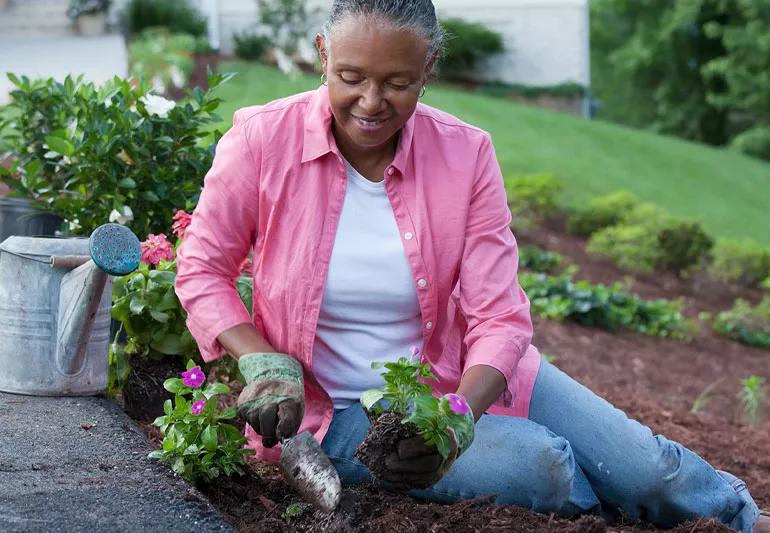Gardening Tips to Boost Your Visual Allure and Neighborhood Charm
Gardening Tips to Boost Your Visual Allure and Neighborhood Charm
Blog Article
Professional Gardening Tips for Creating a Sustainable and Eco-Friendly Garden
Beginning on the trip to develop a environmentally friendly and lasting garden includes a series of purposeful selections and practices that not just boost the beauty of your space yet additionally contribute favorably to the atmosphere. To discover even more experienced understandings and functional strategies, allow us check out the key components that specify an ecologically conscious yard.
Select Indigenous Plants
Picking indigenous plants for your garden is a basic step towards attaining sustainability. Native plants are inherently adjusted to the regional environment and soil problems, making them extra resilient to regional parasites and illness. This lowers the demand for chemical pesticides and plant foods, therefore reducing ecological effect. Additionally, native plants typically need much less water as soon as established, adding to more effective water usage.
Past their practical advantages, native plants play a critical duty in supporting neighborhood biodiversity. They supply vital environment and food resources for native wildlife, including pollinators such as , birds, and butterflies. This cultivates a balanced community, which is crucial for the health of your yard and the surrounding setting.

Implement Water Conservation
Applying water conservation strategies is crucial for keeping a lasting yard. Reliable water usage not only decreases the ecological influence yet additionally makes sure that plants get appropriate hydration without waste.
In addition, mulching is an important technique for preserving water. By using a layer of organic mulch, such as timber chips or straw, around the base of plants, garden enthusiasts can lessen soil evaporation and keep regular wetness levels. Compost additionally assists manage soil temperature level and suppresses weed development, further adding to plant health and wellness.
Rain harvesting is one more lasting approach. Installing rainfall barrels or other collection systems allows garden enthusiasts to save and catch rainwater, which can later on be utilized during completely dry periods. This not just saves community water however additionally offers a natural, chemical-free source for irrigation.
Last but not least, choosing drought-tolerant plant species can substantially lower water demands. These plants are adapted to grow in low-water conditions, making them ideal for eco-friendly gardens. gardening tips. Implementing these water preservation methods will certainly foster a resistant, sustainable yard
Use Organic Horticulture Methods

Pest management in an organic garden depends on integrated pest monitoring (IPM) approaches. These include motivating beneficial insects, utilizing natural predators like ladybugs and lacewings, and implementing crop turning to interrupt pest click this site life process. Companion planting, where particular plants are expanded with each other to push back pests or attract useful insects, is another reliable strategy.
Weed control is handled with mulching and manual elimination, as opposed to counting on herbicides. Mulch not just reduces weeds but also saves wetness and enhances dirt health and wellness as it damages down. Organic mulches, such as straw, timber chips, and leaves, are particularly beneficial.
Create Wildlife Environments
Creating wild animals habitats within your garden not just boosts biodiversity but additionally supports the environment's balance. Begin by including native plants, as these are fit to your local climate and supply crucial food and shelter for wild animals.
Take into consideration including a water function, such as a fish pond or birdbath, to provide a constant water resource. Water elements draw in a selection of types, from amphibians to pollinators, enhancing the garden's vigor. Additionally, setting up birdhouses, bat boxes, and insect resorts supplies safe nesting sites and encourages biodiversity.
Leave some locations of your yard undisturbed, allowing leaf litter and dropped branches to gather. By focusing on these lasting techniques, your yard can come to be a shelter for local wildlife, promoting ecological wellness and sustainability.
Technique Composting and Mulching
An essential element of sustainable gardening, composting and mulching, significantly enhances dirt wellness and minimizes waste. Composting includes recycling organic materials such as cooking area scraps, yard trimmings, and leaves. These products break down to form nutrient-rich important site garden compost, which works as an all-natural fertilizer. Unlike artificial plant foods, compost enriches the dirt with essential nutrients and beneficial microbes, cultivating a healthier garden ecological community.
Mulching, on the other hand, entails covering the soil surface area with organic or not natural products, such as straw, timber chips, or shredded leaves. This method uses numerous advantages: it preserves soil wetness, subdues weed growth, and moderates dirt temperature level. Mulch additionally slowly breaks down, including organic matter to the dirt and more improving its fertility.
To exercise reliable composting, ensure your compost heap has an equilibrium of green materials (rich in nitrogen) and brown materials (rich in carbon), preserving ample aeration and dampness. gardening tips. Routinely transforming the heap accelerates decomposition. For mulching, apply a 2-3 inch layer around plants, ensuring it does not directly get in touch with stems or trunks to stop rot
Verdict

Picking native plants for your yard is hop over to these guys a fundamental action toward accomplishing sustainability.Additionally, including native plants can enhance the aesthetic appeal of your garden. These plants are adjusted to flourish in low-water problems, making them perfect for eco-friendly gardens. Applying these water conservation techniques will certainly promote a resistant, sustainable garden.
In verdict, establishing a sustainable and green yard involves the tactical option of indigenous plants, the fostering of water conservation methods, and the application of natural gardening approaches.
Report this page